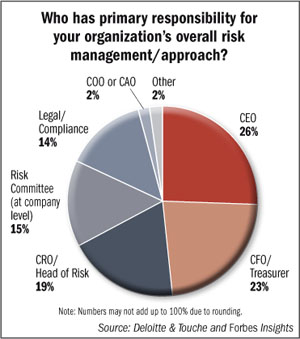 Increasingly, more CEOs and CFOsare taking charge of their companies’ risk-management duties,according to a Deloitte & Touche and Forbes Insights survey—andthe majority of those companies say they plan to implement changesdesigned to raise the profile of risk management throughout theirorganization.
Increasingly, more CEOs and CFOsare taking charge of their companies’ risk-management duties,according to a Deloitte & Touche and Forbes Insights survey—andthe majority of those companies say they plan to implement changesdesigned to raise the profile of risk management throughout theirorganization.
According to the survey, 26 percent of respondents say theprimary responsibility for overall risk management belongs to theCEO, followed by 23 percent who say the CFO or treasurer. The chiefrisk officer/head of risk came in third.
|Deloitte teamed with Forbes Insights to poll 192 riskexecutives, mostly those holding the title of director or vicepresident, working for consumer and industrial products, lifesciences, health care, technology, telecommunications and mediacompanies in the U.S. that make from $1 billion to more than $10billion in revenue.
|Deloitte says it is essential to spread risk awarenessthroughout the entire organization so that all employees feelaccountable, a task for which the CEO is well suited. “There isalways a concern that if you set up a large [enterprise riskmanagement] team, that [the team members alone] own risk. It can’twork that way. People who manage the day-to-day business need toown risk,” Rick Kulevich, senior director of ethics/compliance atbusiness-technology provider CDW, says in the report.
|As for raising the profile of risk management, 91 percent of thesurvey’s respondents say their companies plan to reorganize andreprioritize their approach to risk management in some form withinthe next three years, with 55 percent planning to implement changesover the next 12 months.
|When asked how they plan to do that, 52 percent of thoserespondents say they intend to elevate the profile of riskmanagement throughout their organization; 37 percent say they planto provide additional training for staffers; and 31 percent saythey plan to incorporate new technology.
|Most of these changes are being driven by economic uncertainty:Almost 80 percent of survey respondents state that marketvolatility over the past three years has affected their approach tomanaging and responding to risk.
|“When the financial world collapsed, it resulted in lesstolerance for volatility and less tolerance for surprises,”Kulevich adds.
|“Risk management being elevated to an executive level and beingunderstood by an organization’s C-suite, board of directors andtrustees is a win for our profession,” says Mike Liebowitz,director of risk management and insurance for New York Universityand a member of NU’s Risk Advisory Board. “We have beentrying for an excess of decades to break into senior managementboards to help them really understand what we do.”
Want to continue reading?
Become a Free PropertyCasualty360 Digital Reader
Your access to unlimited PropertyCasualty360 content isn’t changing.
Once you are an ALM digital member, you’ll receive:
- All PropertyCasualty360.com news coverage, best practices, and in-depth analysis.
- Educational webcasts, resources from industry leaders, and informative newsletters.
- Other award-winning websites including BenefitsPRO.com and ThinkAdvisor.com.
Already have an account? Sign In
© 2024 ALM Global, LLC, All Rights Reserved. Request academic re-use from www.copyright.com. All other uses, submit a request to [email protected]. For more information visit Asset & Logo Licensing.








